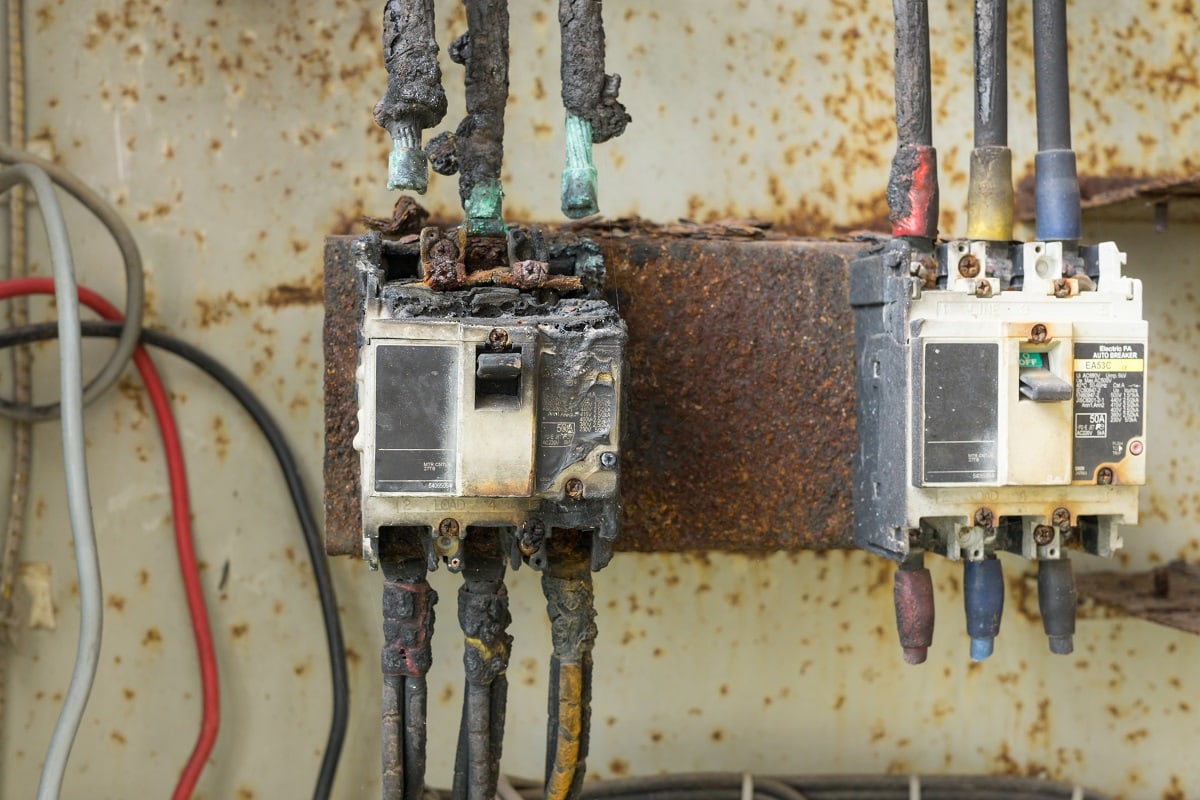When you have a furnace, or any electrical equipment for that matter, one main concern is its safety from generating a fire. And AFCI is the perfect device to prevent this from happening. But does your furnace need it? We looked for significant answers to this question, and here is what we discovered.
The answer is yes. The National Electrical Code (NEC) mandates AFCIs for several household electrical circuits, including furnaces.
Continue reading as we define what an AFCI is, how it works, and the cost of having one. In addition, we'll cover what sets it apart from GFCI and why it is important to have one. We'll also cover what problems you might encounter with AFCIs and how to fix them.

What Does AFCI Stand For?
AFCI stands for Arc-Fault Circuit Interrupters. These are specialized electrical outlets, circuit breakers, and receptacles that are intended to detect and react to potentially deadly electrical arcs in residential branch wiring.
How Do AFCI Circuit Breakers Work?
An AFCI cuts the circuit when it notices the electric arcs that are an indication of faulty connections in residential wiring. Over time, loose connections can develop and, occasionally, get hot enough to start a house fire.
An AFCI selectively distinguishes between a potentially harmful arc and a harmless arc that occurs during the routine functioning of switches, plugs, and brushed motors.
How Do Electrical Arc Faults Happen?

Arc faults are when there is an intermittent contact created by loose or corroded wiring connections that results in an electrical current sparking, or arcing, between metal contact points.
Arcing generates high-intensity heating up to 10,000 °F at the arc's point, easily burning nearby materials like insulation or wood framing.
Generally, there are two ways an arc fault can occur:
1. Parallel Arc Fault
There are two ways that parallel arcing faults might happen: either through a ground fault or a short circuit.
Ground Fault Parallel Arc Fault
Unless a ground path is present, there can there be a ground fault parallel arc fault. A GFCI or an AFCI can clear this kind of arc fault. As opposed to a solid, bolted-type fault, parallel arc faults will have significantly lower RMS current values.
Therefore, this fault might not be cleared by a typical 15A breaker before a fire starts.
Short Circuit Arc
Short circuit arcs weaken the insulation between the conductors' dielectric layers, allowing for the formation of high-impedance, low-current arc faults that carbonize the conductor's insulation and further weaken its dielectric properties.
Increasing current, drastically increased heat energy, and increased fire risk are the end results. The system and arc fault impedance itself control how much current can flow in a short circuit, parallel arc fault.
2. Series Arc Fault
When the conductor connected to the load in series is accidentally broken, a series arc can ensue. A slack connection to a receptacle, a worn conductor in a cord that has separated, or a splice are a few examples.
Arc current in a series arc is limited by the load it is serving, hence it is not possible for it to exceed that limit. Due to extinction and re-ignition, the rms (root mean square) current value with an arc in series is less than that of current without the arc.
Normally, series arcs don't provide enough heat to ignite a fire.
What Are The Types Of AFCI?

Depending on the application, there are four types of AFCI which are:
- Combination AFCI: This AFCI type is most frequently used in main distribution panels to safeguard branch circuits and the loads attached to them.
Click here for this product on Amazon!
- Outlet Circuit AFCI: This device protects chord cables plugged into the outlet for sets and power supplies against parallel and series arc faults. It does not, however, offer parallel arc-fault prevention upstream of the device or arc-fault protection on conductors of feed-through branch circuits.
- Branch/Feeder AFCI: Similar to a panelboard, this component is installed at the start of a feeder or branch circuit. It offers parallel arc-fault prevention for power supply cords, cord sets, and branch circuit wiring. The provision of series-type arc-fault protection is not UL-Listed.
Click here for this product on Amazon!
- Portable AFCI: It is a plug-in appliance similar to an extension cord that fits into any standard outlet or receptacle that has no AFCI protection. Any appliances or loads connected to the portable AFCI are protected.
How Do AFCIs Differ From GFCIs?
The operation of an AFCI differs significantly from that of a GFCI in several key ways:
- While AFCIs are designed to protect against fire, ground-fault circuit interrupters only protect against shock.
- The purpose of the GFCI is to shield users from the potentially fatal effects of electric shock that could happen if a ground fault causes some components of an electrical tool or appliance to become activated.
- The purpose of the AFCI is to guard against dangerous arcing faults that could start an electrical fire and harm the branch circuit wire.
- The technologies of AFCI and GFCI can coexist with one another and are an excellent complement for the circuit's fullest possible protection.
Why The Need For An AFCI?
Arc fault fires are especially hazardous because they frequently originate in wall cavities, attics, and other locations where a smoke alarm won't be able to detect them until it's too late.
The National Electrical Code (NEC) orders the installation of AFCIs in nearly every room of newly constructed homes since they have been shown to be so successful at preventing electrical fires.
The rare exclusions include bathrooms, garages, and unfinished basements, which are classified as non-living spaces. Every time an addition, an additional circuit, or even an additional outlet is added to an existing home, the NEC also mandates the installation of AFCIs.
You can think about replacing the important outlets in each circuit one at a time if your wiring is outdated or you want your electrical system to have the best protection possible.
How To Install AFCI?
Here is a brief guide on how to install an AFCI:
- Place the breaker in place and attach the neutral bar's pigtail.
- The breaker should be turned on and, if required, reset.
- Hit the test button. It ought to trip the breaker.
- Disconnect the breaker.
- Connect the neutral (white) and hot (black) wires of the load to the breaker.
- Activate the breaker.
Avoid common wiring mistakes, including distributing neutrals, grounding the neutral across the system, and linking the neutral bar in place of the breaker's neutral terminal, connecting the load neutral (white) cable.
What To Do When The AFCI Breaker Trips?

An AFCI trip alerts you to a potential electrical wiring problem that, if not fixed, could result in an electrical fire.
You and your family's safety will ultimately increase by looking into and figuring out why AFCIs trip. So, to learn how to deal with a tripped AFCI. Here are some possible scenarios and how to deal with them:
Scenario #1: When a load is applied, AFCI trips immediately.
To fix this issue, you must:
- Check if the trip affects all loads every time. If no, then the AFCI tripped maybe because of high inrush of current. If yes, check for grounded neutrals.
- To check, disconnect the breaker. From the breaker, remove the loads hot and neutral. Check the continuity between the neutral bar in the panel and the load neutral using an ohm meter.
- Verify if the load neutral and the neutral bar are continuous.
- If there is no continuity, with a 3-wire run or by linking the neutrals of two distinct circuits in the same switch box, you can check for a shared neutral. Verify at the breaker if the neutral and hot wires are correctly connected.
- If continuity is present, to find the point at which the neutral touches the earth, inspect the whole circuit, paying close attention to each connection.
Click here for this product on Amazon.
Scenario #2: AFCI trips immediately in the absence of a load.
Here is a brief guide to fix this issue:
- When this happens, the first thing to do is to check if the breaker correctly operates. You can do this by disconnecting the breaker's hot and neutral load. But you should leave the neutral bar's pigtail. Then turn it back on after resetting the breaker.
- If the breaker stays on, check for a short. Turn off all light switches and unplug everything, even surge-protected outlet strips. Check to see whether there is a break between either the hot and ground or the hot and neutral load.
- Again, if there is continuity, check the entire circuit to see where the neutral or ground is coming into touch with the hotwire—paying close attention to each connection.
- But, if the breaker doesn't power on, check the utility voltage by measuring the voltage between the neutral and line.
- If the reading is less than 135 VAC, then your AFCI is broken. You must swap it out for a fresh breaker. Otherwise, you should take this matter up with your utility provider.
How Much Does It Cost To Buy And Install An AFCI?
The overall cost of purchasing and hiring a professional to install an AFCI breaker might range from $200 to $400 or more, depending on the additional work required.
The AFCI breaker alone costs from $25 to $90, while the replacement or installation costs between $160 and $300.

Final Thoughts
For new house constructions, the NEC requires the addition of AFCI for 120-volts, 15A and 20A, and single-phase branch circuits. Furthermore, having this device helps in ensuring your safety from dangerous arc faults resulting in electrical fire hazards.
If you enjoyed this post, you could go check out our other articles here:
Why Is My Furnace Heating Past Set Temperature?
Carrier Furnace High Limit Switch Keeps Tripping - Why And What To Do?




